Back to the NIKA2 run 9 main page
Contents
February, 21st (Tuesday)
Martino, Alicia, Alessia, Juan, Charles, Florian, Jean François, Pablo arrived this morning, Nico was already here.
IMPORTANT NOTE ON ALIGNEMENT: during maintenance, the atmosphere was not very stable. So, finding the center of the pupil by moving the eccosorb foil in front of the window was impossible: the signal produced by the eccosorb was comparable to the oscillati'ns of the atmosphere, unless we entered pretty 'violently' in front of the window. We guess that we could have achieved a precision of (maybe?) 1cm, so decided to keep as good the previous position, found during run 8. Mounting the laser, Santiago, Dave, Alicia and Martino found that the spot was 1cm off from where it should be (1cm higher). This lead them to move M6 to fix it: a 1cm decrease of the whole cryostat seemed unlikely.. For the time being, we accept this configuration.
On a happier note: the noise in the KID traces seemed at first glance to be pretty good. The PT only give a few rays in the spectra, no signs of the big 'bump' that was present in January and that hints to a touch between PT and 4K plate. So maybe the pressure cycle of the gain helped us in this sense. But, be careful: to confirm on a good and stable sky!
16h30 : Wind is still too high to start observing. Weather seems pretty opaque and the forecasts are not good so far.
17h30 or so: started observing! But, high tau and a lot of wind, unstable atmosphere and KID noise largely dominated by atmospheric effects. Stopped at 20h due to high wind. It looks like we'll have to wait a couple of days before having better weather. But, who knows, we might have good surprises!
Despite the weather conditions, we were able to do a few pointings : the action on M6 or the realignement overall induced a pointing shift of (17,15) arcsec ! We could also run one or two focus sequences and two skydips. Reducing the skydips, taking their C0 and C1 and putting them in the reference kidpar (that dates back to January) and re-analysing scan 21s51 that is not too far from a good focus, we find fluxes of 30Jy at 1mm and 13Jy at 2mm, when we expect 37 and 16. Given all the caveats, the high opacity (0.4 at 1mm) and the weather conditions overall, it's pretty encouraging !
February, 22nd (Wednesday)
No observations last night. This morning the wind is still too strong.
About 1pm the wind calmed down while fog was still very present. We started the joint EMIR/NIKA2 skydip session.
6pm: Pablo is reducing the EMIR data, we're starting with NIKA2. The opacity is very high, we start by two skydips to have a comparison point with EMIR. Then we'll test the "purpose" and "comment" keywords added to focusOTF*pako. Opacity is so high we're not likely to do any meaningful observation and the weather forecast are very bad for tonigh (storm and/or snow).
7.30pm : opacity still very high but stable wind, we're doing a true skydip session
8pm: We have to stop, the wind is rising up. 9pm : storm and snow
February, 23rd (Thursday)
10.30: very high opacity, but the wind has stopped, so we're on for another skydip session
11.30: wind seems to be rising up again
11.42: it's snowing now
15:00: Just before lunch, dark measurements on KIDs: the frequency shift is -300 kHz on 2mm and -150 kHz on 1 mm with respect to parameter file. A bit (a lot!) worrying is the 'bump' on KIDs noise spectra that starts to appear, hinting to a touch between the PT head and the 4K plate. We decide to adjust the height of the PT by playing (veeeery delicately) with the positioning screws. We manage to make the bump disappear, although we still see some peaks at PT harmonics. After a little investigation, we realize that it is actually not an intrinsic problem but it is a consequence of the window not being fully closed -> its vibration give some kind of optical pick-up? So, once we improve this and carefully close all optical access, also the peaks disappear --> very good noise level and shape obtained! Dark pixels identified.
Here below a few images:
Window on the cryostat, Array2 : noise spectrum before the intervention.
Window on the cryostat, Array2 : noise spectrum after the intervention, window not completely tightly closed.
Window on the cryostat, Array2 : noise spectrum after the intervention, window well closed.
18.20: Many clouds in the sky and many more approaching, but we have small slot without wind, we take it.
21:30: still clouds, but not so bad, we have done a nice skydips, a beammap on Uranus, we're doing one 3C84 that we'll follow as much as the weather allows us to (no primary calibrator available with a large enough flux to overcome opacity reliably).
0.20: Still opacity around 0.3-04 as given by the tau-meter, but not much wind. We stay on Vesta, and do skydips regularly.
February, 24th (Friday)
2:00 am : starless night, no wind, high opacity (~0.5) ; Vesta at moderate elevation , skydips, a strong quasar, back to Vesta at low elevation. Resonances and acquisition nominal (KIDs at 190mK and stable. A serie on 3C273 till we catch secondary calibrator MWC349
6:00 am : start to see stars.
8:00 am : high thin clouds. we cycle thru MWC349, NGC7027, CRL2688. Resonances and acquisition nominal (KIDs at 190mK and stable). Small change of levels of feet at 7:10 UT.
11 am : focusing, looping on planets as primary calibrators. Wind is rising up.
12.30 : big clouds coming up from everywhere, the current beammap defocused sequence might be not usable. Not much we can do with this weather.
1.pm : wind and fog, we can barely see the antenna from the control room, we definitely can't see the ski lift...
1 pm: We change the roughing pump duoAux and install the new one. No leaks, working fine.
February, 25th (Saturday)
1am : We could restart observing around 0h30. The weather was still poor, and Alicia and Martino had already installed the calibrator this afternoon, so we could start right away with 2 scans with the calibrator on. Then we benefited from EMIR previous set up to run a smooth joint EMIR-NIKA2 skydip session.
3:30 am : opacity down to 0.3, we can see the stars. Sixteen minutes on Vesta at 20deg in better weather than yesterday. We are not sure how stable is the weather though.The noise rms at 1Hz (blue histogram) is below 100 Hz, i.e. about 3 times lower than yesterday. The noise after decorrelation (red histogram) is below 10Hz, also lower than yesterday. We might have observed anomalous refraction in TOI's during scans 49 and 61. Although our appreciation of the weather stability is not crystal clear, we decide to make a small pointing session since no calibrators are up.
5:30 am : ending of the pointing session of 18 sources done in 1h 30 ; there are two clear correlations El-El and AZ-El in the Excel table.
6:00 am : As already noted in previous days, difference in Z focuses between A1 and A3 is 0.1mm. Tonight, we notice that A2 was quasi-identical with A1 earlier on but now A2 is very close to A3. Athought fits were good, uncertainties might be an issue.
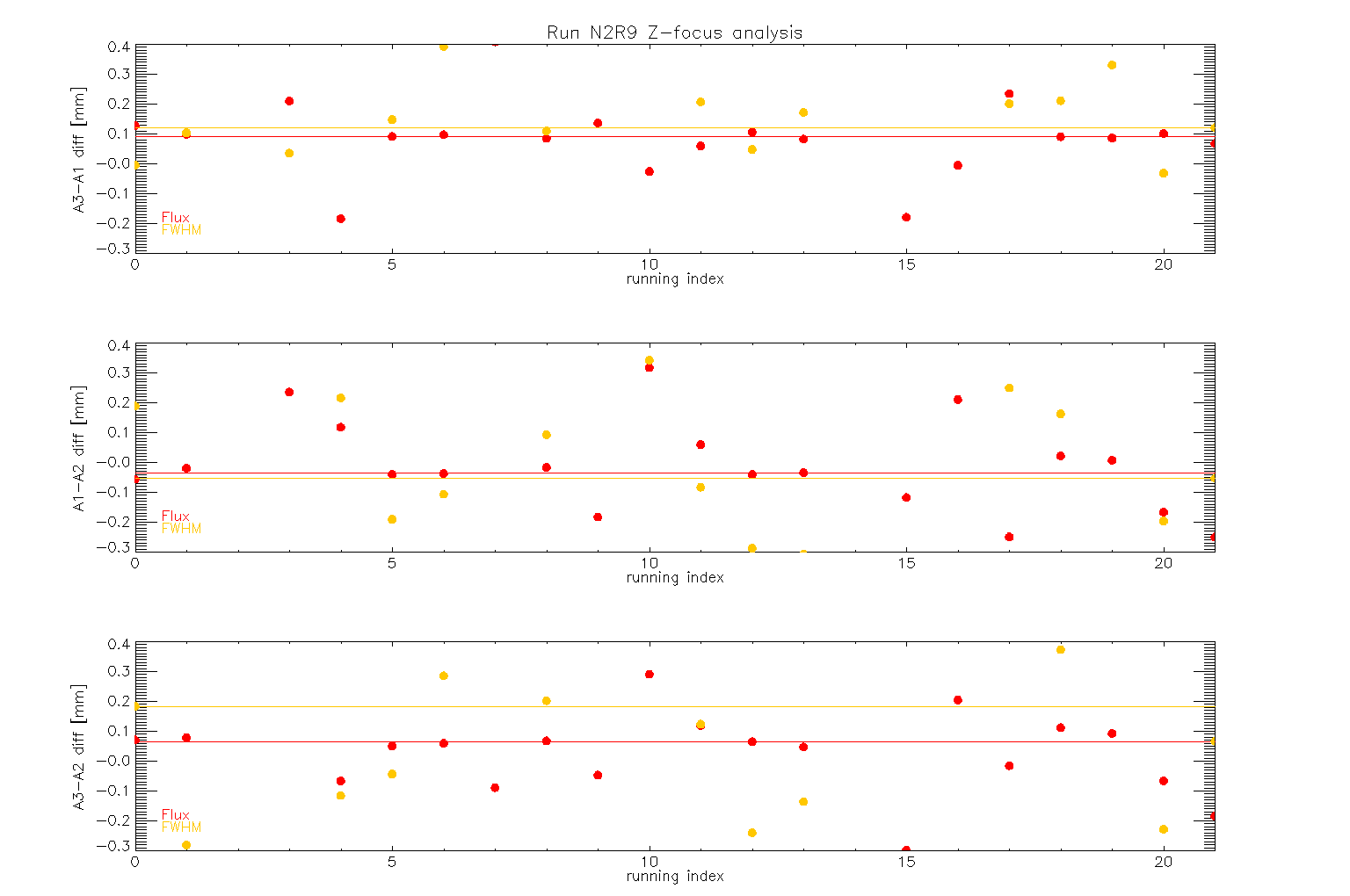
Focus differences between the three arrays for run9 till now (all fits are shown - highest differences are likely from poor fits)
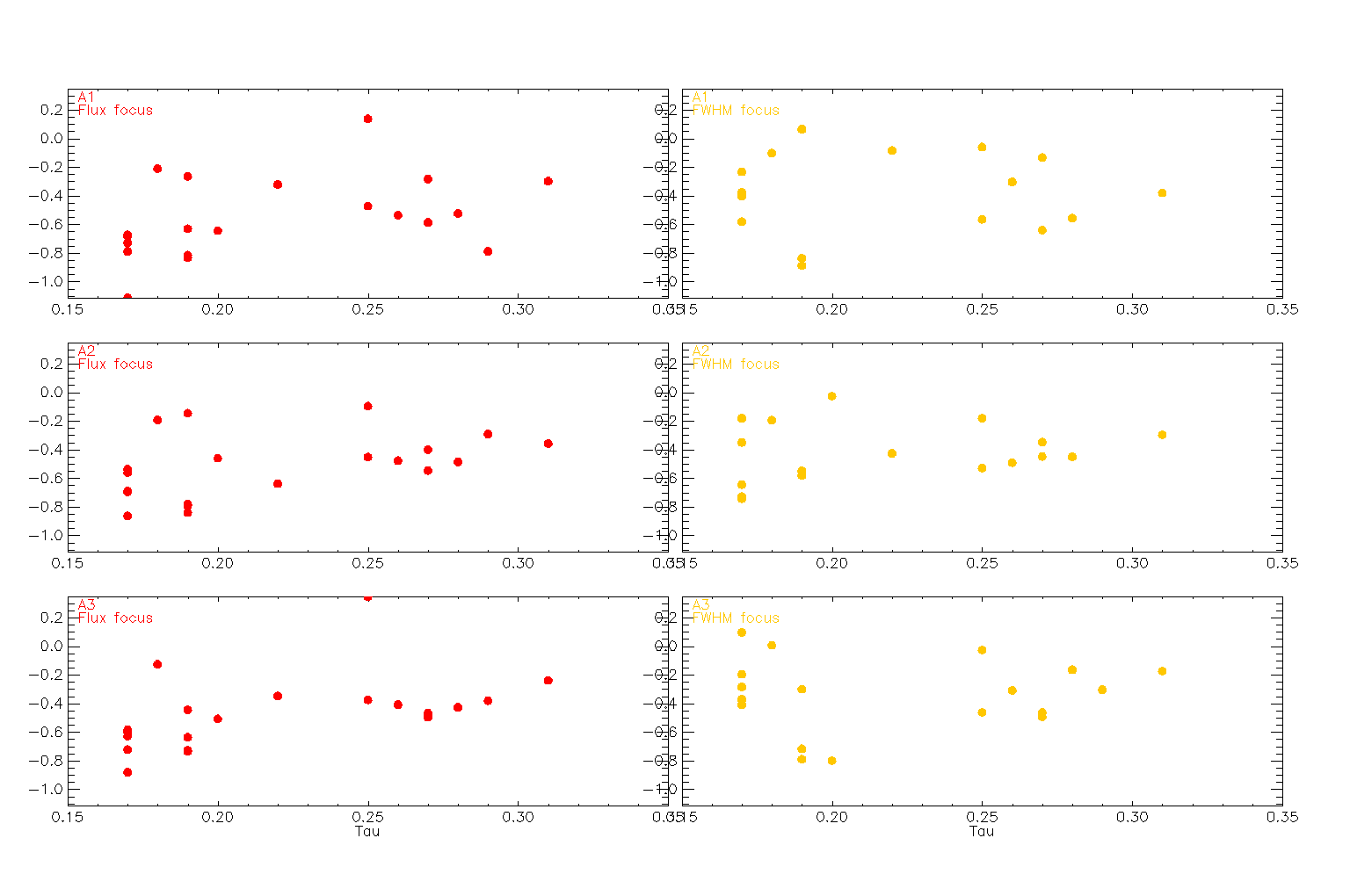
Flux Foci and FWHM foci versus tau from run9 till now
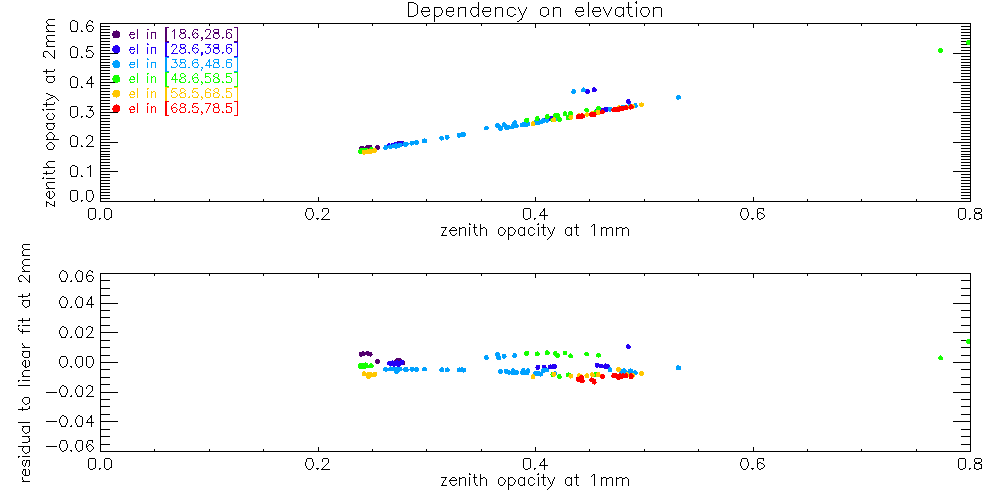
Opacities
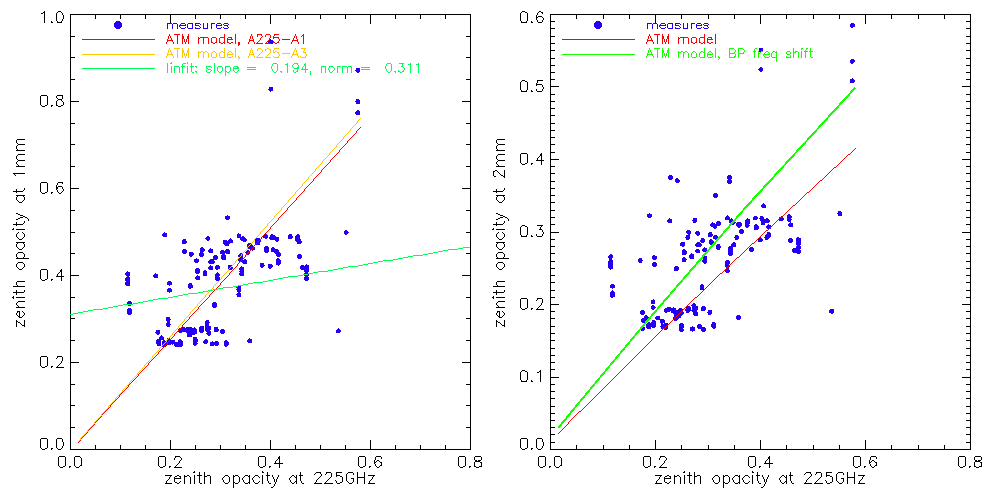
Lack of correlation of Tau_225 with tau1mm and tau2mm.
16h00: we've been observing smoothly since the morning, monitoring focus and flux or primary calibrators at different elevations. About half an hour ago, we tried a new pointing set up with offsets computed by Albrecht based on last night's pointing session. They turned out not to improve the current offsets we find. We decided to set back the ptg model we've been using since the beginning of the run and redo a pointing session before getting too close from sunset.
19h50: The small pointing session seems to give compatible results with that of last night. We'll redo another one tonight far from sunset. Meanwhile, we resume to alternate sequences of otf8x5 maps on primary calibrators, focus, skydips.
22.45: starting a new pointing session
The figure below shows the time of box F around midnight - it jumps to <-40000 sec ! RZ, Feb 27
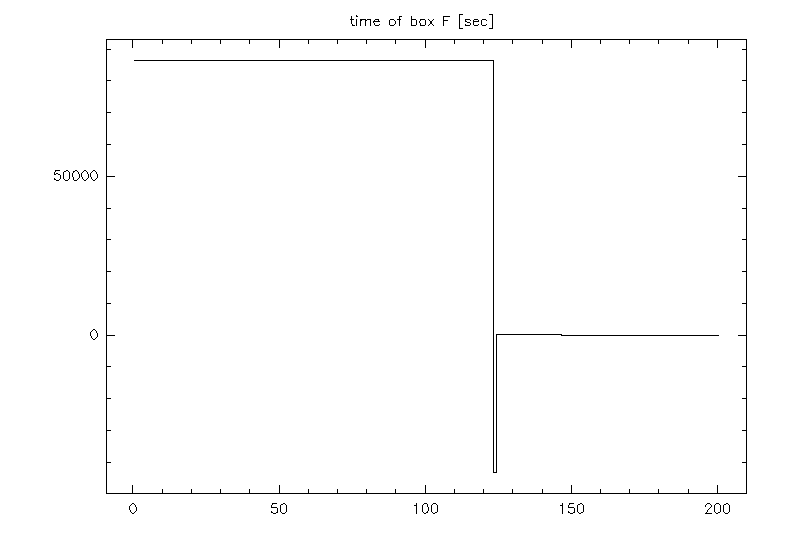
February, 26th (Sunday)
1.40: The pointing session allowed us to derive approximate NASMYTH OFFSETS that we'll use for the rest of the night. We've did a beammap on 3C273 with these, and we're now going to integrate on a faint source that has a bright pointing source nearby to monitor the noise.
2:30 We can see the stars. The "skynoise-meter" read off the KID monitoring display conveys the impression that the weather is very stable (The red and blue histograms overlapped and are centered around 10Hz). This is unlike last night and even worst the night before.
- rta display shows jumps for a few detectors at scan # 36.
5:30 We see the stars. Atmosphere is very stable according to red and blue histograms. We finished the faint
8:30 Observation of HLS091828 between 3:25UT and 4:31UT reduced using COMMON_MODE_KIDS_OUT. Stable weather conditions and opacities 0.28 at 1mm and 0.19 at 2mm.
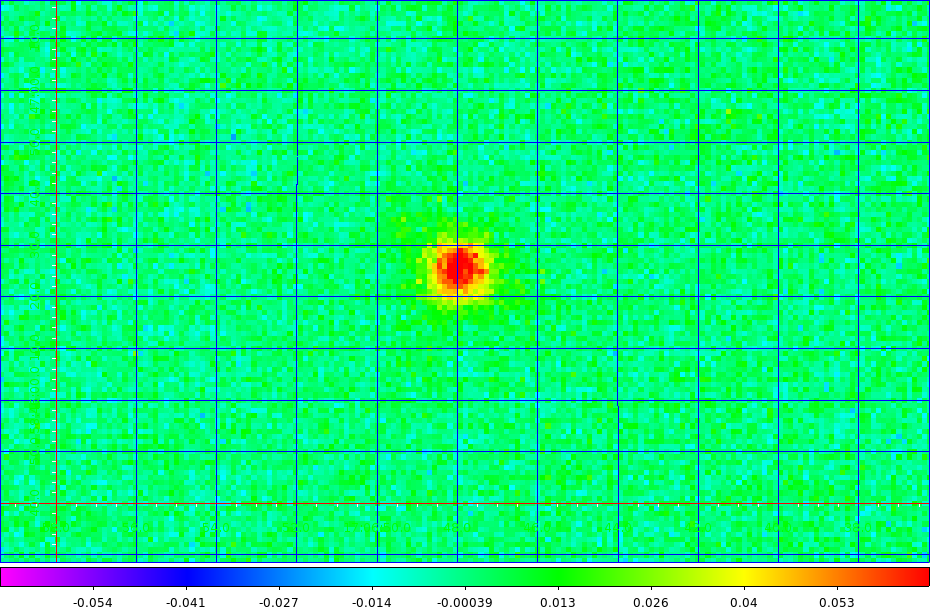
NIKA2 map of HLS091828 at 1mm. Measured flux= 80 mJy (a priori flux = 36.7 mJy). Scale in Jy/beam.
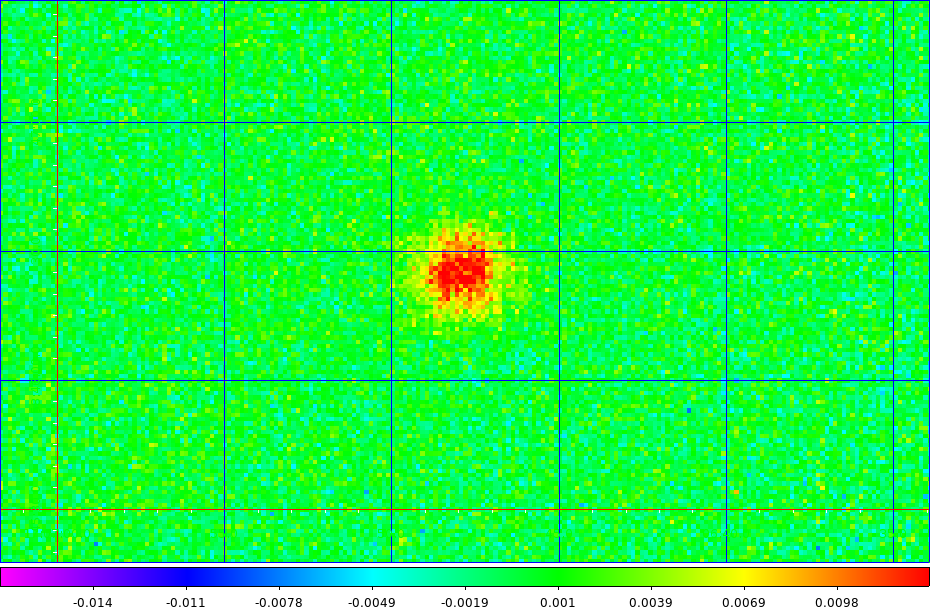
NIKA2 map of HLS091828 at 2mm. Measured flux = 13 mJy (apriori flux = 8.3 mJy). Scale in Jy/beam.
1pm: We've been strugling with the focus this morning, because of the Sun ? Trying different sources... From the instrument side: the Turbo HP400 starts to warm up! Alicia and Martino go to the cabin to check, but everything seems correct. T has passed from 26 to 45°.. But seems stable. Drive current is 1A, within specificiations. After a couple of hours, T decreases again to about 35 and stays there. KEEP AN EYE on it!
Afternoon : after extensive tries on different sources, elevations, azimuth we were convinced that something wrong was going on with the telescope. In coordination with Carsten, Samuel and the operators, we also tested with EMIR and also found a problem.
6pm PT noise in the traces! Luckily, it is solved just before the antenna is given back for NIKA2 observations.
6.15pm: after interventions of the operators [CK: the operators did not do anything, but the sun set.][Nico: didn't he reboot some temperature control software ? They rebooted one control PC, but this should have no influence. I'd say that at present it is not yet clarified what happened yesterday, and today (27-Feb) again. (CK)], we saw that things were going back to normal with EMIR. We retook the telescope and immediately saw things were ok. The first pointings and focii were nominal.
10.30pm: we've done a defocused beammap sequence on 3C84 to make sure we have one such sequence asap. We're doing another beammap at optimal focus, then we'll go to monitor Vesta after a skydip.
[LP, Feb. 27: Plots below show the focus surface relative to the focus at the center for the scan series [20170226s415-419] using the method "2" described in [http://www.iram.fr/wiki/nika2/index.php/Mapping_of_the_Z-defocus_across_the_FoV]]
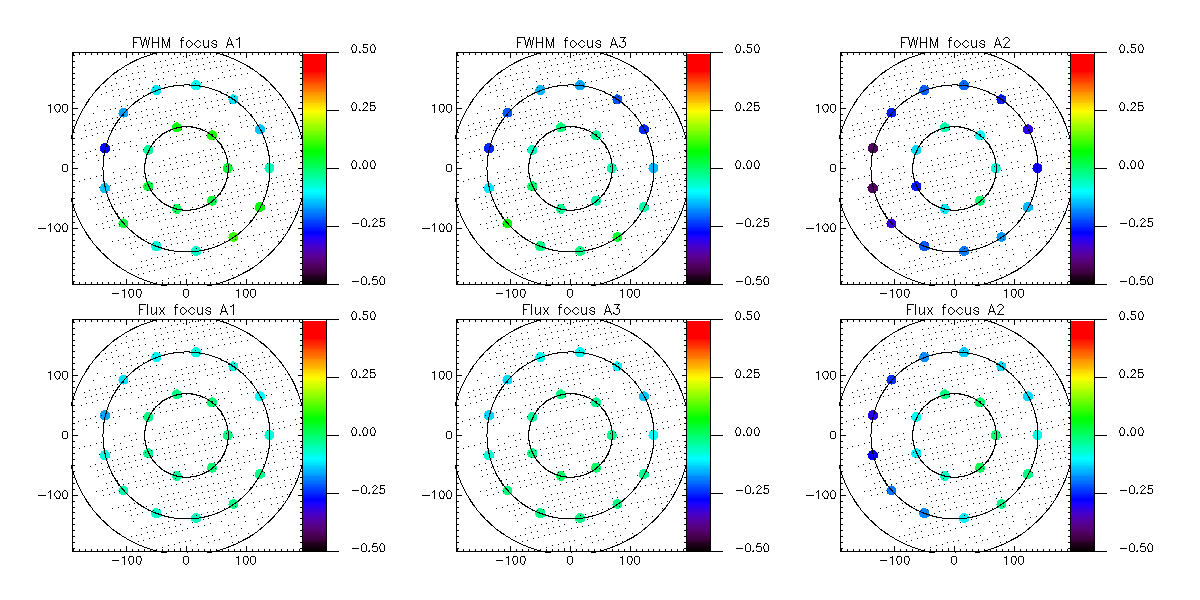
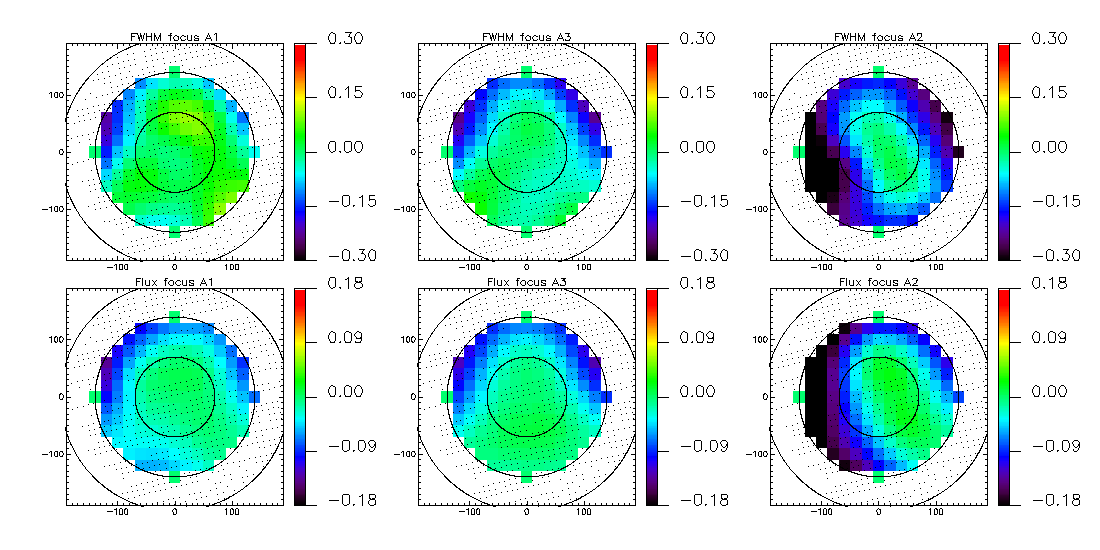
Comments:
- for this scan series on 3C84, the elevation spans from 60 to 40 degrees
the results are basically consistent with what we had for N2R6, namely:
for the 1mm-arrays: focus difference <= -0.1mm within a radius of 70arcsec and in the lower part of the array, and up to -0.3mm in the upper of annulus at 140 arcsec from the center;
- for the 2mm array : focus differences reach about -0.5 mm at 140 arcsec from the center in the left part
- focus estimates relying on the FWHM (upper row) are generaly larger than those relying on the peak amplitude (lower row) by about 30-40%.
Few examples of time instabilities of different boxes. RZ, Feb 27
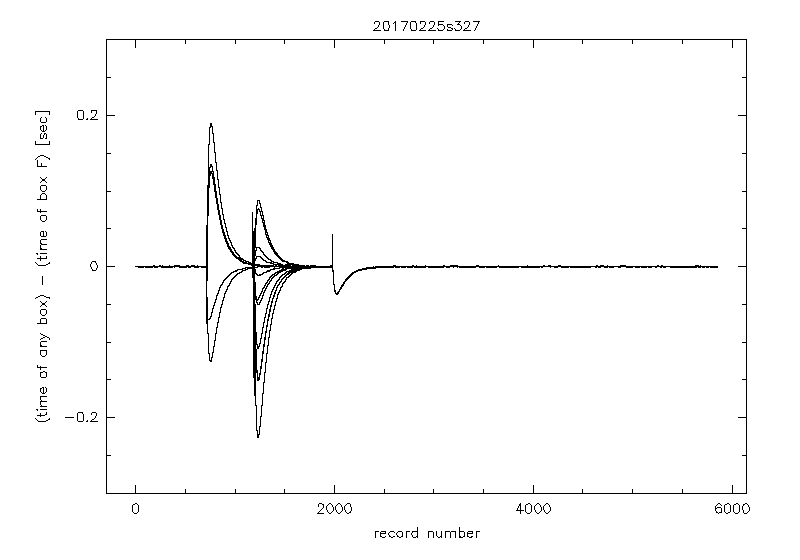
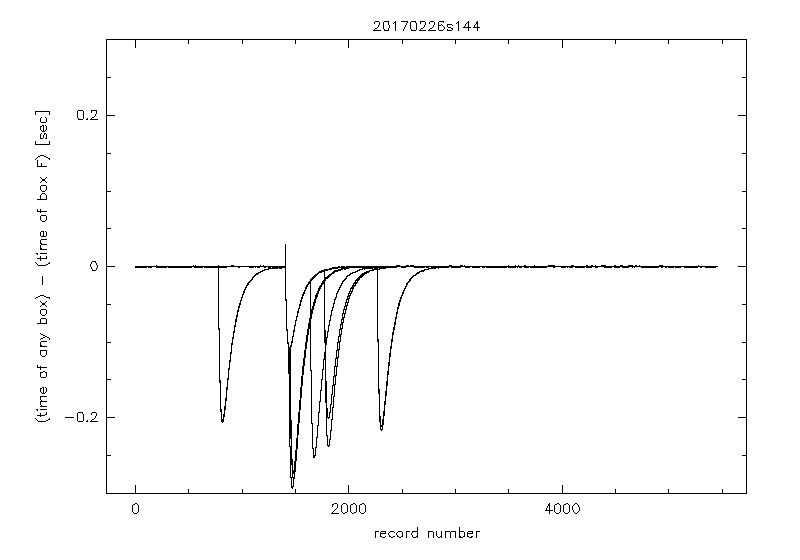
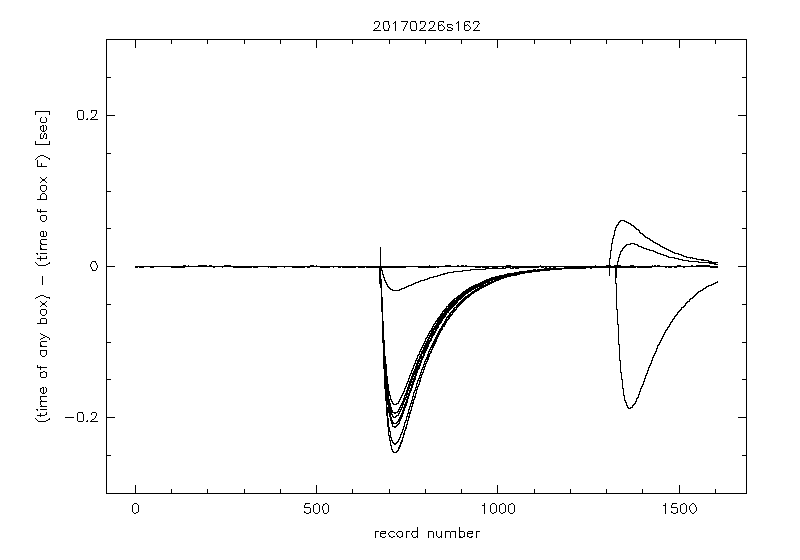

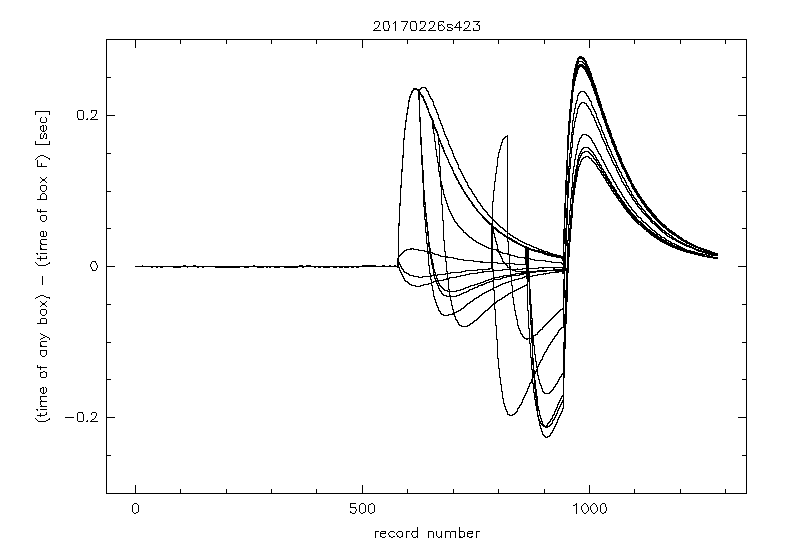
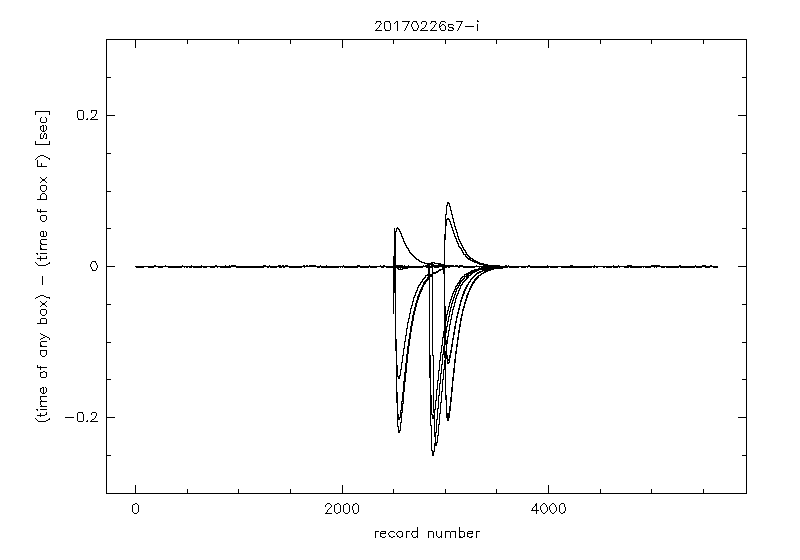
February, 27th (Monday)
0am Again, PT noise in the traces! Bad news! We make a session to show to the people present how to fix it. Hopefully it will not be needed tomorrow.. But in any case keep a close eye on the time traces to monitor the noise spectra.
1am: We start integrating on HLS091828 like last night. Low opacity (0.15) but less stable atmosphere than last night from the skynoise-meter (red and blue histograms separate more, by about 100 Hz most of the time).
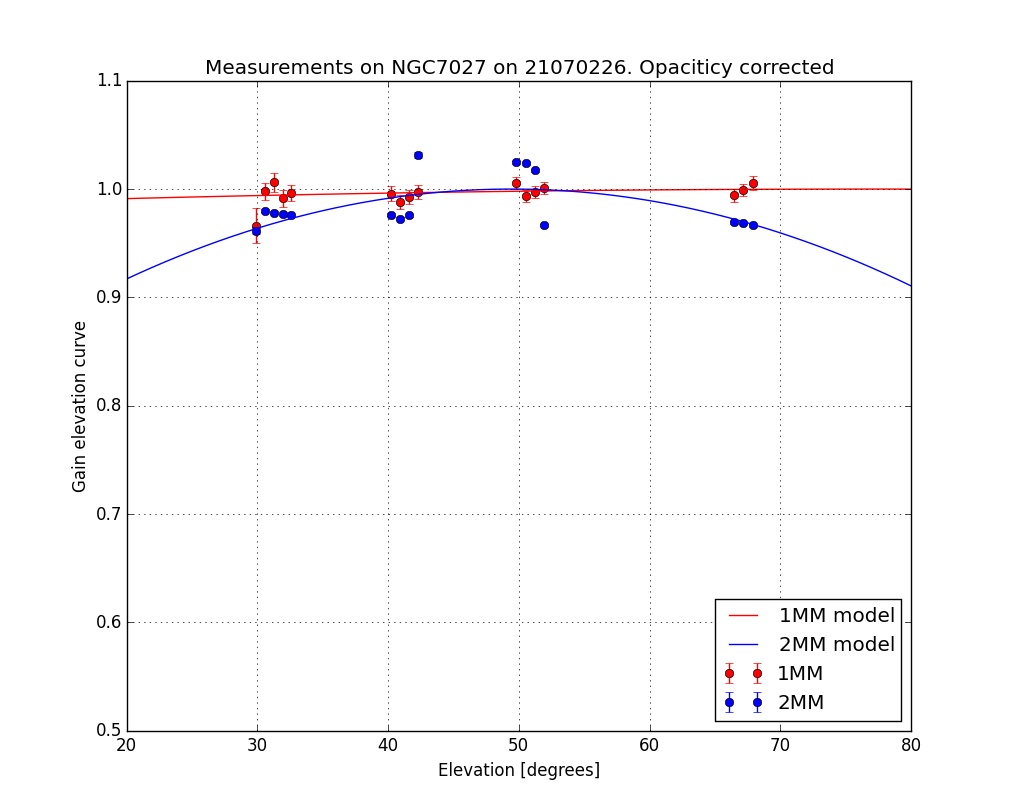
- This is our first attemp to replicate gain elevation curves at 1 and 2mm as done in Penalver's study : Adjustment is a second order polynomial fit that has been normalised by the peak. [CK: From todays daily teleconf, it seems that the gain-elevation curve is already applied in the IDL pipeline using the paper of Greve et al. 1998.]
* [RZ: really strange that @2mm flux errors are much larger than @1mm, due to ar2 instabilities showing up in the fig. below as 3-10 times increased rms ?]

- Faint source HLS091828 observed for 3 hours for NEFD studies.

Verification of flux calibration in using planets and asteroids only of runs 8 and 9.
Analysis : same kidpar for both runs ; Pipeline opacity corrections ; Flux scale is set by one observation of Uranus (index #1) ; aperture photometry radius=150" ; decorrelation mask=100".
Issues under investigation :
* Uranus flux ratio at index #1 is not exactly unity.
* Presence of a jump between runs #8 and 9 in the flux of Uranus.
But internal consistency within each run is better than 10% as shown by flux ratios in bottom plot.
February, 28th (Tuesday)
Excellent weather : see stars, opacity < 0.1, skynoise-meter gives a sense that atmosphere is stable. We carry out a long track for about 4 hours on HLS091828 for NEFD studies. Then, secondary calibrators and PLUTO as a test of a faint source with known flux density from model.
at 8:00 UT the Kid monitor indicates that BOX O is orange and its dot is red and oriented down, unlike the other BOXES. We let it go for this last hour of run9. We assume that data will be automatically flagged during processing if not usable.
